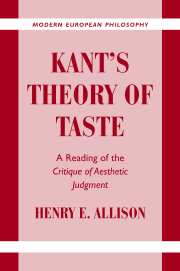Book contents
- Frontmatter
- Contents
- Acknowledgments
- Note on Sources and Key to Abbreviations and Translations
- Introduction
- PART I KANT'S CONCEPTION OF REFLECTIVE JUDGMENT
- PART II THE QUID FACTI AND THE QUID JURIS IN THE DOMAIN OF TASTE
- PART III THE MORAL AND SYSTEMATIC SIGNIFICANCE OF TASTE
- 9 Reflective Judgment and the Transition from Nature to Freedom
- 10 Beauty, Duty, and Interest: The Moral Significance of Natural Beauty
- 11 The Antinomy of Taste and Beauty as a Symbol of Morality
- PART IV PARERGA TO THE THEORY OF TASTE
- Notes
- Bibliography
- Index
10 - Beauty, Duty, and Interest: The Moral Significance of Natural Beauty
Published online by Cambridge University Press: 18 January 2010
- Frontmatter
- Contents
- Acknowledgments
- Note on Sources and Key to Abbreviations and Translations
- Introduction
- PART I KANT'S CONCEPTION OF REFLECTIVE JUDGMENT
- PART II THE QUID FACTI AND THE QUID JURIS IN THE DOMAIN OF TASTE
- PART III THE MORAL AND SYSTEMATIC SIGNIFICANCE OF TASTE
- 9 Reflective Judgment and the Transition from Nature to Freedom
- 10 Beauty, Duty, and Interest: The Moral Significance of Natural Beauty
- 11 The Antinomy of Taste and Beauty as a Symbol of Morality
- PART IV PARERGA TO THE THEORY OF TASTE
- Notes
- Bibliography
- Index
Summary
It was suggested in Chapter 9 that the cultivation of taste and the experience of beauty contribute to the development of morality, and therefore help to bring about the required transition from nature to freedom, in two distinct ways: One is by giving rise to an intellectual interest in natural beauty in virtue of the fact that such beauty appears to provide an intimation of nature's moral purposiveness; the other, which applies to both natural and artistic beauty, is by helping to wean us from an excessive attachment to sensuous interests and egocentric involvements with the world, as a result of which it may be said to symbolize morality. The first of these is the subject matter of the present chapter.
In addition to the previously discussed sections II and IX of the Second Introduction, a key text in laying the foundation for Kant's account of the connection between taste and morality is §40. Of particular significance in this regard is Kant's claim that taste has more of a right to be considered a sensus communis than the common human understanding, because it involves a capacity in mere reflection to abstract from private factors and evaluate the formal features of a representation from a universalistic standpoint (KU 5: 293–4; 160). Clearly, already implicit in this characterization are the analogies with moral reflection and decision that make taste suitable both as a preparation for and as a symbol of morality. In other words, the very features that entitle taste to be described as a sensus communis are those that ground its connection with morality.
- Type
- Chapter
- Information
- Kant's Theory of TasteA Reading of the Critique of Aesthetic Judgment, pp. 219 - 235Publisher: Cambridge University PressPrint publication year: 2001



